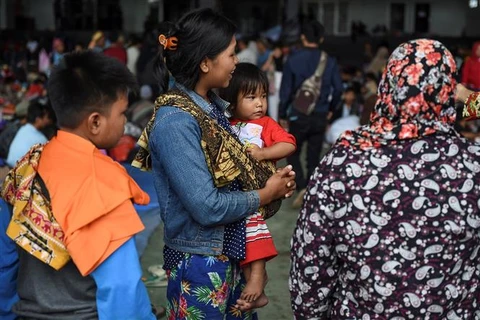Hanoi (VNA) – Indonesia's tsunami which occurred on December 22 has raised fears that another deadly wave could wipe out the few dozen Javan rhinos still living in the wild, conservation authorities said on December 28.
There are believed to be fewer than 70 individuals of the critically endangered species at the Ujung Kulon National Park on the western tip of Indonesia's main island of Java, not far from the Anak Krakatau volcano that triggered a deadly tsunami on December 22.
None of the animals are believed to have been killed in the disaster, but officials are warning that another deadly wave could slam into the stricken region.
That is putting pressure on conservationists at the national park to ramp up a longstanding plan to find a suitable secondary habitat for the rhinos.
Plans to find a second home for the species have been in the work for about eight years, with conservationists surveying areas all over Java and neighbouring Sumatra but so far without success.
Head of the Rhino Conservation Foundation of Indonesia Widodo Ramono said if there is only one habitat for the animals and another tsunami strikes the area, the rhinos could be wiped out completely.
The creature once numbered in the thousands and roamed across Southeast Asia.
However, poaching and human encroachment on its habitat has led to a dramatic population decline.
Indonesia, one of the most disaster-prone nations on earth, straddles the so-called Pacific "Ring of Fire", where tectonic plates collide and a large portion of the world’s volcanic eruptions and earthquakes occur. Anak Krakatau is one of the 127 active volcanoes which run the length of the archipelago.-VNA
There are believed to be fewer than 70 individuals of the critically endangered species at the Ujung Kulon National Park on the western tip of Indonesia's main island of Java, not far from the Anak Krakatau volcano that triggered a deadly tsunami on December 22.
None of the animals are believed to have been killed in the disaster, but officials are warning that another deadly wave could slam into the stricken region.
That is putting pressure on conservationists at the national park to ramp up a longstanding plan to find a suitable secondary habitat for the rhinos.
Plans to find a second home for the species have been in the work for about eight years, with conservationists surveying areas all over Java and neighbouring Sumatra but so far without success.
Head of the Rhino Conservation Foundation of Indonesia Widodo Ramono said if there is only one habitat for the animals and another tsunami strikes the area, the rhinos could be wiped out completely.
The creature once numbered in the thousands and roamed across Southeast Asia.
However, poaching and human encroachment on its habitat has led to a dramatic population decline.
Indonesia, one of the most disaster-prone nations on earth, straddles the so-called Pacific "Ring of Fire", where tectonic plates collide and a large portion of the world’s volcanic eruptions and earthquakes occur. Anak Krakatau is one of the 127 active volcanoes which run the length of the archipelago.-VNA
VNA

























